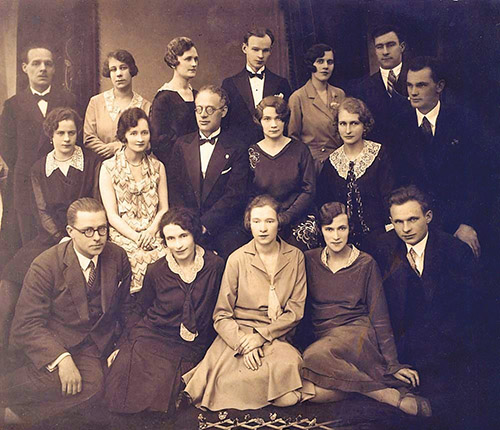

In December of 1930, Samuel Abramovich Maikapar, the scion of a prominent Crimean Karaite family of tobacco merchants residing in Riga, submitted a request to the chief Karaite chacham, Seraya Shapshal, to allow his daughter Inna to marry her Rabbanite fiancee, the attorney Horacio Bernhardt (his real surname, however, seems to have been “Blumenthal”).
While in general very much opposed to marriages between Karaites and Rabbanites, Shapshal initially relented but asked that the Maikapars officially adopt their prospective son-in-law and thereby give the couple and their offspring their Karaite surname.
Horacio obviously did not care about getting Rabbanite approval (which would have been impossible as Ashkenazic rabbis had prohibited intermarriage with Crimean and Eastern European Karaites for hundreds of years).
The exact circumstances of Blumenthal’s romance with the Karaite maiden Inna Maikapar seems unclear (it should be pointed out that another Karaite-owned tobacco company, Szyszman and Duruncza—this one in Vilna—was the only Karaite company that hired Rabanite assistants. Additionally, they were the only Karaites who greeted Theodore Herzl on the occasion of his visit to Vilna), but be it as it may, they were determined to get married and she (unlike him) wanted her father’s blessing.
The patriarch Maikapar did what any good Eastern European Karaite would do: seek the blessing of the chief Karaite chacham of that time.
Now the Karaite chachamim of Crimea and Eastern Europe had long opposed intermarriage with Rabbanites (for the same reason that the Rabbanites opposed unions with them, namely “chashash mamzerut,” literally suspected faulty lineage, as Rabbanite and Karaite laws of incest differ (this is expressed succinctly in the Eastern European Karaite Mordecai ben Nisan’s apologetic work Levush Malchut, or Royal Attire, now available in a new edition, with an English translation at The Karaite Press; see https://the-karaite-press.myshopify.com/collections/all/products/copy-of-royal-attire-on-karaite-and-rabbanite-beliefs).
It would seem that Shapshal, who was usually very much opposed to such unions, made an exception in this case (perhaps Maikapar’s prominent standing played a role).
When some Karaites from Trakai, Lithuania—long a center of Karaites— received word of this, they created such a clamor that Shapshal was forced to pull back and retract his blessing for the union.
The wedding went ahead anyway on the 28th of December, 1930, after which Horacio took on the double surname of Bernhardt-Maikapar, while Inna also took on her husband’s surname, Blumenthal.
Whether the ceremony was conducted by a renegade Karaite chacham or by a city clerk is not clear; however, the fact that all of them perished makes me suspect that they were not officially on the Karaite community rolls, since members of the community were not targeted by the Nazis.
They were both murdered when their hiding place was betrayed by locals who coveted their fortune. Horacio and Inna were shot along with their children, Sergey and Juris, by the Nazis in 1941.
*Much of this information was culled from Mikhail Kizilov’s comprehensive book on Karaites in Eastern Europe “Sons of Scripture,” p. 202. See here https://www.degruyter.com/view/title/510399.
The author is an independent historian and can be reached at yoelswe@gmail.com.
By Joel Davidi Weisberger










